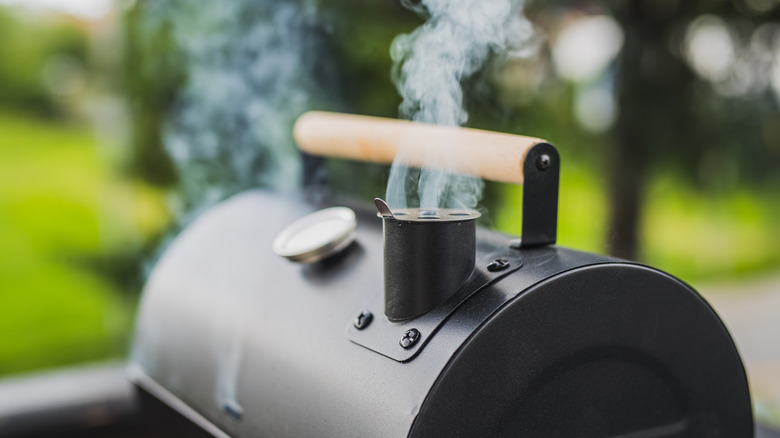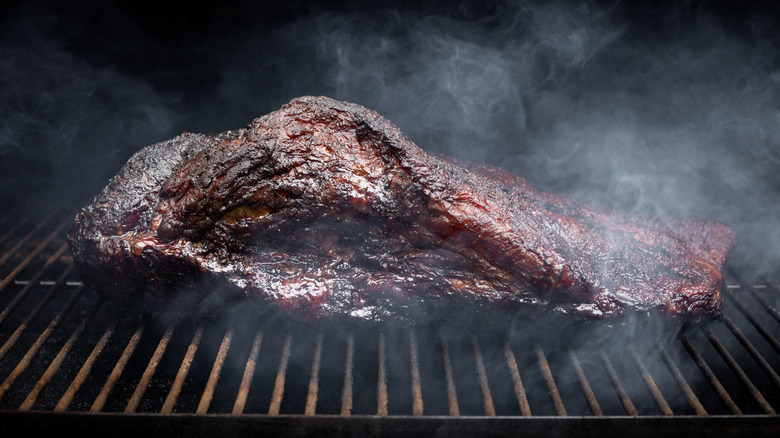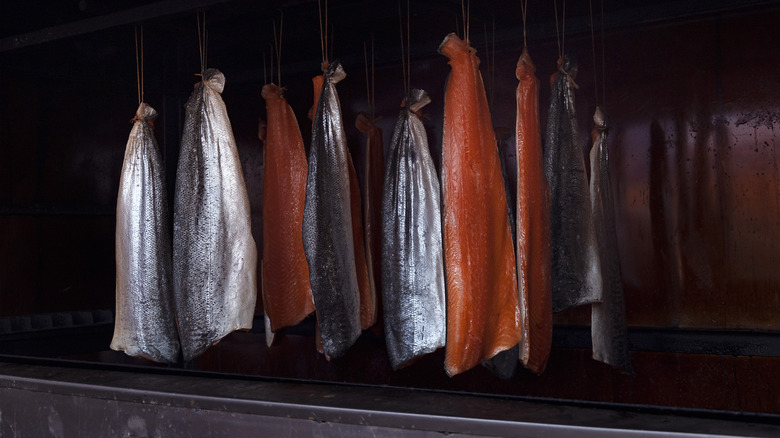The Best Cuts Of Meat You Should Stick To For Smoking
Any meat grilled over charcoal will have a smoky taste, but that's not to say that they've been smoked because that's a distinction with a difference. Grilling tends to be a rapid, high-heat affair, while smoking is its opposite: Perfectly smoked meat is done "low and slow" (as Southerners will affirm) over indirect heat and utilizing the smoke itself as a cooking agent. (And we mean low — smoker temperatures are usually kept around 225 degrees Fahrenheit.) Because grilling and smoking are two very different techniques, there is also a different criterion you should use when choosing which animal protein to smoke. The best solution (especially if you're just starting out) is to pick meats with a higher fat content, especially of the marbled variety.
Of course, you can smoke any darn thing you want, and experimentation is encouraged! But for foolproof smoking, choose a cut that is inherently self-basting. This is because the process is drying — there's a reason smoke was traditionally used as a preservative. Lean cuts of red meat, poultry, and fish will transform into shoe leather in the time usually required for smoking, whereas grilling them with hardwood charcoal will supply much of the smokiness you need without overcooking. So, what are some reliably good smoking meats?
Get a clue from barbecue
The two great traditional Southern barbecue meats are ideal smoking choices. The Southeast tends to smoke pork shoulder, also known as Boston butt. Shot through with fat, this cut can be pretty unappetizing unless placed over a bed of hickory coals and lovingly smoked until it reaches an internal temperature of 195 degrees Fahrenheit, at which point all that marbling melts, acting as the world's greatest baste. Then, it's simply a matter of allowing it to cool and "pulling" the cooked meat away from fat and bone. What's sold in the store as country-style ribs aren't actually ribs but strips of meat from the shoulder. Smoke 'em up.
Texans tend to prefer beef brisket, a cut from the lower part of the cow's chest. There's a strong argument to be made that, at least for non-indigenous people, they borrowed the concept of smoked brisket from Jewish immigrants' pastrami. Regardless, brisket is fatty enough to smoke wonderfully; look to get its internal temperature almost as high as pork, about 180 degrees Fahrenheit. Mesquite is a beautiful wood for smoking brisket. Beef short ribs are actual ribs and magnificent candidates for smoking: once the marbling fat renders and all that connective tissue loosens up, they become meltingly tender and juicy.
Birds, fish, and wood smoke
You can successfully smoke comparatively lean poultry like chicken and turkey, with two caveats: Use the whole bird and be sure to brine them beforehand. (Brines are essentially an extended water bath of salt, sugar, and optional aromatics.) Your target internal temperature will also be much lower — shoot for 165 degrees Fahrenheit in the breast meat. Choose from a variety of hardwoods for this application: Hickory never fails, while cherry or apple wood will add a gorgeous fruity essence to these milder meats.
You're going to want to brine salmon as well if you want it to have a chance in the smoker, with the caveat that you let it thoroughly dry before cooking. You're also going to be operating your smoker at a much lower temperature as well, no higher than 175 degrees Fahrenheit. Try alder wood for smoking fish — it's more delicate and a touch sweet. Smoked salmon is divine but also a bit tricky to pull off. Think of it as an ultimate destination, with Boston butt and beef brisket as the first two stops along the way.


